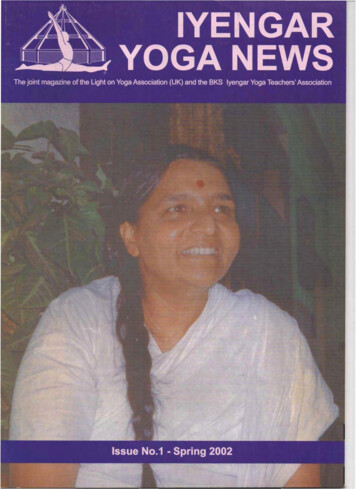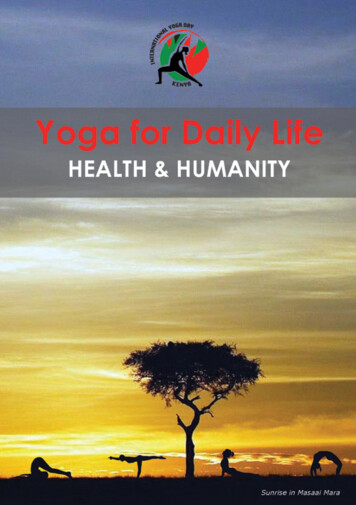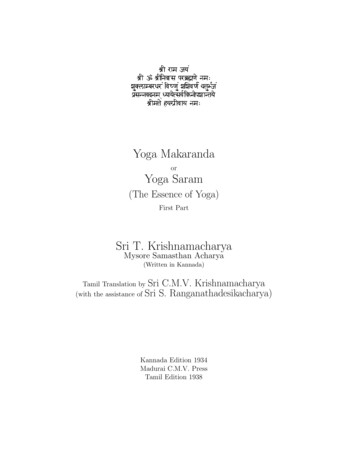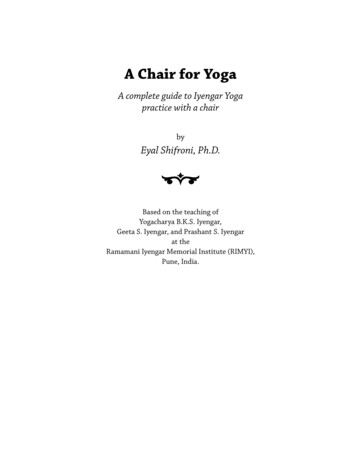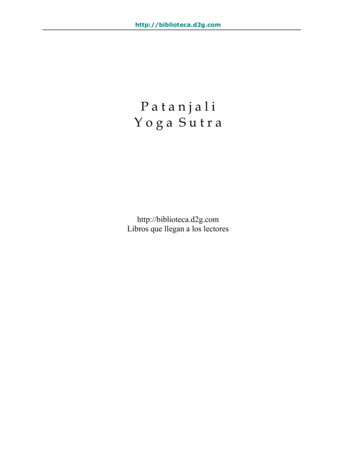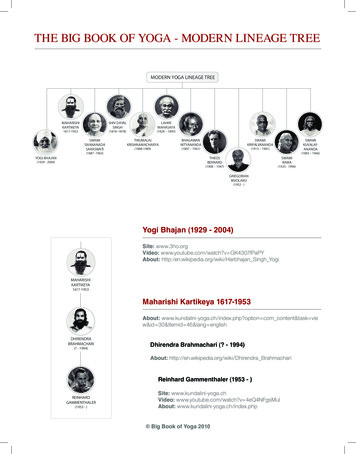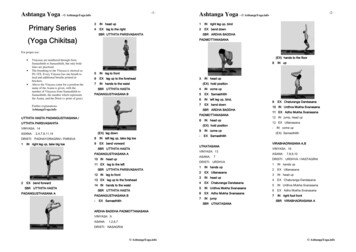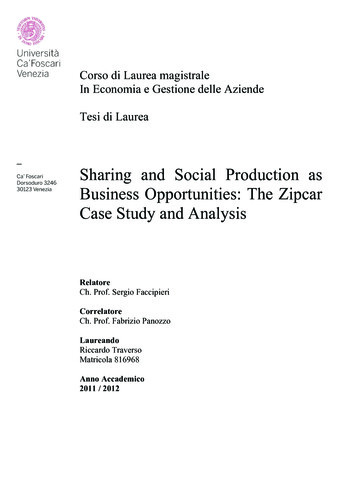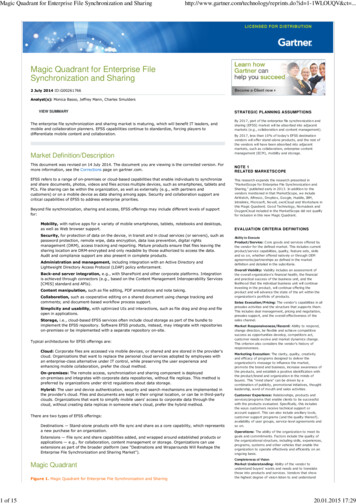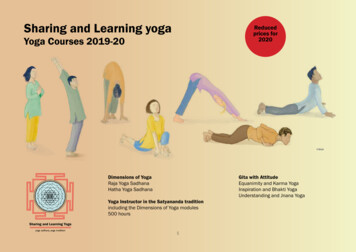
Transcription
Sharing and Learning yogaReducedprices for2020Yoga Courses 2019-20Dimensions of YogaRaja Yoga SadhanaHatha Yoga SadhanaYoga Instructor in the Satyananda traditionincluding the Dimensions of Yoga modules500 hoursSharing and Learning Yogayoga sadhana, yoga tradition1Gita with AttitudeEquanimity and Karma YogaInspiration and Bhakti YogaUnderstanding and Jnana Yoga
Index Our Vision, our valuespg 03 About the Dimensions of Yogapg 04 There are two Dimensions of Yoga modulespg 05 Dimensions of Yoga modules dates and pricespg 05 Dimensions of Yoga Hatha Yoga Sadhanapg 06 Theory, practices and texts for Hatha Yoga modulepg 07 Dimensions of Yoga Raja Yoga Sadhanapg 08 Theory, practices and texts for Raja Yoga modulepg 09 Yoga Instructor in the Satyananda Traditionpg 10 Theory and practice for the Yoga Instructor modulepg 11 Texts, dates and prices for Yoga Instructor modulepg 12 Course delivery and development timelinepg 13 Structure of Sharing and Learning YogaPg 13 Our teachers pg 14 Connections and partnerships Policies and procedures pg 16 Strategies for transition and recognition of prior learning Practical details pg 18 Cancellation and refund policy Payment details pg 19 New Gita with Attitude series Calendar - timeline pg 22 Application information pg 232pg 15pg 17pg 19pg 20
Our vision, our valuesYoga Sadhana, Yoga traditionThe vision of Sharing and Learning Yoga is to make available the livingyoga of the Satyananda tradition in a way that empowers the practitioner to develop their own sadhana (personal practice and lifestyle).Our goal is to provide participants with yoga tools and strategies thatenable them to better manage life’s opportunities and challenges,stand on their own two feet, and lead fulfilled and resilient lives.Our belief is that true Yogic insight emerges through integration of thepersonal practice of yoga in one’s daily life. Personal understanding ofthe essence of yoga develops through this immersive journey.We encourage openness to learning, self-reflective curiosity, and takingpersonal responsibility.With the flowering of these skills, we encourage the development ofa less self-orientated approach to life and a concern to relieve thesuffering of others.Mutual respect is central to the Sharing and Learning Yoga approach.3
About the Dimensions of YogaThe Dimensions of Yoga are all about making yoga a part of living. Theyare structured to facilitate the integration of yoga into daily life whiledeveloping capacity and self-understanding.Learning yoga through personal experience,reflection and integration in life.Daily practice builds and evolves over the three months of each module.This includes: Regular self-reflective daily practice develops the capacity tomanage in life, to stand on one’s own two feet. Guidance from experienced senior teachers each with over 25years of experience. A holistic, structured, and systematic approach to learningyoga. Practices, concepts and strategies taken directly from classictexts on Yoga, presented in an accessible and relevant way,informed by a living tradition. Developing foundations for improved health and wellbeing,habits for living a balanced life. Fostering positive approachesto manage physical capacity, energy, thoughts and actions. Becoming immersed in the practices. This develops informedlived personal experience of the practices and theory (not justacademic knowledge). Tools and skills for reflective awareness and strategicchange in everyday experiences, fosters self-understanding,acceptance, empowerment and transformation. Take control ofyour life. Experience living in a traditional ashram as part of eachmodule as well as strategies to make yoga a more integratedpart of your life at home.4Yoga practicesdrawn froma living traditionApplication& reflectionin ashramenvironmentYoga conceptsdrawn froma living traditionApplication,reflection &consolidationin daily lifeat home
There are two Dimensions of Yogamodules that may be taken in eitherorder.The combination of residential and home practice is set up so there isa dynamic mix of concepts, practices, and integration in daily life.Together, with regular practice and reflection, through the lens oftraditional concepts, knowledge becomes embedded in experienceand personal understanding.Although Hatha Yoga is traditionally emphasized as occurringprior to Raja Yoga, it is possible to take these modules ineither order because of the approach taken. In sadhana itis necessary to manage both energy and mind, and theseaspects are addressed holistically across both modules.Each module will consist of a week long residential followedby 11-14 weeks of guided home study and practice followedby a final residential weekend. Options are available to helpfacilitate students travelling from a distance.Home practice is multi-layered to enable students to takeresponsibility, with guidance, to establish the practices thatbest suit their situation and capacity,“Someone withand incrementally develop froma high levelthere.of physicalcapacity willfind challengesas will someonewhose body willthrive on simplerpractices.”Dimensions of YogamoduleCommencementdateStructurePriceRaja YogaIntake A202012 - 19 Jan 2020w/e 27 -29 Mar7 Day residential14 weeks homeprac and study.Study weekendHatha Yoga202022-29 May 2020w/e 7-9 Aug7 Day residential14 weeks homeprac and study.Study weekendon time 1600Raja YogaIntake B202011-18 Sep 2020w/e 4-6 Dec7 Day residential14 weeks homeprac and study.Study weekendon time 1600on time 1600late entry 2000late entry 2000late entry 2000A “yoga capsule” approach isincorporated in the home practice.For example, Pawanmuktasana1, 2, and 3 and Surya Namaskarawill occur in both modules but thepriorities and themes will reflect thepriorities of the module (Hatha Yogaor Raja Yoga). The emphasis in thesemodules is on personal sadhana.Standard shared residential accommodation and meals are includedwith the fee. Catering for some special dietary needs is possible. Otheraccommodation options may be available through direct arrangementwith Rocklyn Yoga Ashram.Similarly, each module incorporates a “yoga with attitude”,“living consciously” type strand in the home practice.For example, the Hatha Yoga module explores the sevenattainments of Gheranda Samhita and the Raja Yoga moduletakes its focuses from Patanjali’s Yoga Sutras.Fees subject to change without further notice.Manuals, comprehensive audio resources and some key texts, areprovided as part of the fee. Additional books will need to be purchased.See list of resources, concepts and practices on page 7 (Hatha YogaModule) and 9 (Raja Yoga Module).Key concepts from the texts studied become integrated into,and reflected upon, in everyday life. Practice is integratedwith understanding of the tradition.5
Dimensions of Yoga Hatha Yoga moduleHatha Yoga is often thought of as the asanas (postures) thatare commonly known as “yoga” throughout the world. Othersknow Hatha Yoga as a series of cleansing practices. Both theseunderstandings are part of Hatha Yoga, but there is much more tothis branch of yoga.The Dimensions of Yoga: Hatha Yoga Sadhana module is structuredaround the seven limbs of Hatha Yoga and the seven associatedqualities or attainments, taken from Gheranda Samhita, atraditional text with much poetic insight into the overall goals ofHatha Yoga and how to reach them. These seven limbs are: Shatkarma, the cleansing practices for which theattainment is purification, Shodhanam, Asana, for which the attainment is firmness, Dridhata. Mudra and Bandha, for which the attainment is stillness,Sthairyam. Pratyahara, for which the attainment is patience,Dhairyam. Pranayama in which the attainment is lightness,Laghavam. Dhyana in which the attainment is patience or innerperception, Pratyaksham Samadhi in which the attainment is non involvementwith the mind, NirliptamAlthough the classic texts such as Gheranda Samhita and HathaYoga Pradipika go deep into advanced practices, the themes andpractices in this course are approached simply, and explainedclearly in ways that are accessible for most potential participants.Practices are a selection of basic and intermediate practices thatare flexibly designed to be undertaken at the level of the practitioner,and support development of self-understanding and capacity overtime. The practices include basic and classic shatkarmas, asanas,pranayamas, mudras and bandhas (introduction only), based onthose documented in Hatha Yoga Pradipika and Gheranda Samhita,presented in straightforward and accessible ways, interpretedaccording to the Satyananda tradition, particularly as described inthe classic text Asana Pranayama Mudra and Bandha by SwamiSatyananda. In meditation the practices include Kaya Sthairyam,Ajapajapa, and Chakra Shuddhi.As well as a close investigation of Gheranda Samhita and HathaYoga Pradipika, key concepts related to Hatha Yoga, including nadis,chakras, prana, and koshas, will be investigated in a practical wayas tools for experiencing, balancing and enhancing the energeticaspects of living.“The Hatha Yoga modulereally consolidated myknowledge of yoga:revealed what I did knowand what I didn’t know. Itdeepened my knowledgeand I can now build on this.”6
Theory, practices and texts for Hatha Yoga moduleTexts:Supplied text 2019 (2020 subject to change): Gheranda Samhita Hatha Yoga Pradipika Shatkarma, asana, mudra, bandha (intro),pratyahara, pranayama, dhyana, fromperspective of hatha yoga. Seven sadhanas (attainments) fromGheranda Samhita Nadis, prana, Chakras Koshas Mahabhutas (elements, tattwas) Principles of sadhana according to Hathayoga perspective. Hatha yoga as an essential set of tools forany serious yoga practitioner. Hatha yoga as an important aspect ofyogic lifestyle. Branches of yoga are presented in anoverview with other branches defined androles explained.A comprehensivemanual of originalmaterial includingaudio recordingswill also beprovided. Swami Niranjanananda, Gheranda Samhita (Supplied)Essential: Swami Satyananda, Asana Pranayama Mudra Bandha Swami Muktibodhananda, Hatha Yoga Pradipika Swami Sivananda and Swami Satyananda, Conversationsseries – Hatha Yoga (volume 8)Optional: 7Swami Sivananda and Swami Satyananda, Conversationsseries – Hatha Yoga (additional volumes in the series of 8)
Dimensions of Yoga Raja Yoga moduleThe classic text on Raja Yoga by Patanjali, the Yoga Sutras, is oftenthought of in terms of meditation and the inner journey. First steps onthis journey quickly reveal, however, that, in order to proceed, everyaspect of life and yoga practice needs to be looked at together, whetherit is yoga practice, managing one’s thoughts, one’s daily routine,or one’s interactions with others. Only then is consistent progresspossible.The Yoga Sutras contain many concise jewels, useful tools andstrategies, for understanding and managing the patterns of the mind,including skills for self-reflection and developing sustained regularpractice. Patanjali helps us develop understanding of the nature of theobstacles we place in our own path and provides powerful techniquesfor overcoming them.This module explores the experience of developing sadhana, throughthe prism of this classic text, in the light of the Satyananda traditionof yoga. This is done with the understanding that yoga is about takingresponsibility for one’s own life, developing self-understanding and apositive approach to living. When these skills are developed, any goalis possible.This module is a foundation part of the course Yoga Instructor in theSatyananda Tradition. For existing Yoga Teachers, as a standalonemodule, it provides comprehensive exploration of Raja Yoga which willhelp with instructing students in meditation, insight into developingPratyahara, the fundamental Satyananda practices, and strategies forintegrating yoga into daily life.“There is so much gold in the YogaSutras, it is only really valuable whenapplied in life: in action, practice andreflection.”“I liked the experiential learning.”8
Theory, practices and textsfor Raja Yoga moduleA comprehensivemanual of originalmaterial includingaudio recordingswill also beprovided.Themes and practices:Texts:Supplied: Swami Satyananda, Four Chapters on Freedom(Patanjali’s Yoga Sutras), (supplied).Essential: Swami Satyananda, Asana Pranayama Mudra Bandha Swami Satyananda, Meditations from the Tantras Swami Satyananda, Yoga Nidra Swami Niranjanananda, Mind, Mind Management andRaja Yoga Swami Niranjanananda, SadhanaOptional: Swami Satyananda and Swami Sivananda, Sadhanathe path of transformation Swami Niranjanananda, Yoga Darshan Patanjali’s Yoga Sutras: Raja yoga concepts and goals of Yoga Detailed investigation of Patanjali’s 8 limbs of Yogaincluding links to relevant practices. Detailed investigation of key concepts suchas: Drashta, Abhyasa, Vrittis, Vairagya, Viveka,Pratipaksha Bhavana, Kleshas, Sanyama Obstacles and how to overcome them. Yogic Discipline according to Patanjali Understanding and managing the patterns of themind. Yoga practice for management of mind. Om Gayatri mantra Yoga Nidra theory Principles of Meditation Categories of asana and relationship to Raja Yoga Categories of pranayama and relationship to RajaYoga Yogic concepts of mind. Raja yoga practice is looked at in detail as animportant aspect of yogic lifestyle. Branches of yoga are presented in an overview withother branches defined and roles explained.“The combination of theory and practice wasbeautiful and allowed us to get inside theconcepts, to breathe life into them.”9
Yoga Instructor in the SatyanandaTraditionThe Yoga Instructors’ module will contain 2 separate, 7 day, ashramresidential intensives. Residential 1 at the beginning, followed by 11weeks of home practice and study including practical experience ofinstruction. This will be followed by Residential 2, including assessmentfor key p
Ajapajapa, and Chakra Shuddhi. As well as a close investigation of Gheranda Samhita and Hatha Yoga Pradipika, key concepts related to Hatha Yoga, including nadis, chakras, prana, and koshas, will be investigated in a practical way as tools for experiencing, balancing and enhancing the energetic aspects of living. Dimensions of Yoga Hatha Yoga module

